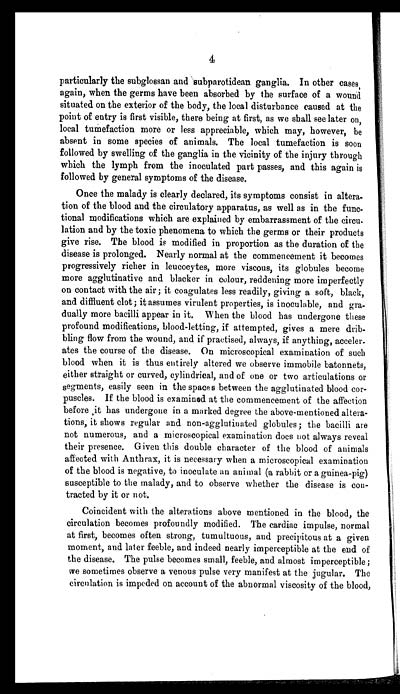Medicine - Veterinary > Civil Veterinary Departments > Civil Veterinary Department ledger series I-VI > Volume II - Anthrax
(102) Page 4
Download files
Individual page:
Thumbnail gallery: Grid view | List view

4
particularly the subglossan and subparotidean ganglia. In other cases
again, when the germs have been absorbed by the surface of a wound
situated on the exterior of the body, the local disturbance caused at the
point of entry is first visible, there being at first, as we shall see later on,
local tumefaction more or less appreciable, which may, however, be
absent in some species of animals. The local tumefaction is soon
followed by swelling of the ganglia in the vicinity of the injury through
which the lymph from the inoculated part passes, and this again is
followed by general symptoms of the disease.
Once the malady is clearly declared, its symptoms consist in altera-
tion of the blood and the circulatory apparatus, as well as in the func-
tional modifications which are explained by embarrassment of the circu-
lation and by the toxic phenomena to which the germs or their products
give rise. The blood is modified in proportion as the duration of the
disease is prolonged. Nearly normal at the commencement it becomes
progressively richer in leucocytes, more viscous, its globules become
more agglutinative and blacker in colour, reddening more imperfectly
on contact with the air; it coagulates less readily, giving a soft, black,
and diffluent clot; it assumes virulent properties, is inoculable, and gra-
dually more bacilli appear in it. When the blood has undergone these
profound modifications, blood-letting, if attempted, gives a mere drib-
bling flow from the wound, and if practised, always, if anything, acceler-
ates the course of the disease. On microscopical examination of such
blood when it is thus entirely altered we observe immobile batonnets,
either straight or curved, cylindrical, and of one or two articulations or
segments, easily seen in the spaces between the agglutinated blood cor-
puscles. If the blood is examined at the commencement of the affection
before it has undergone in a marked degree the above-mentioned altera-
tions, it shows regular and non-agglutinated globules; the bacilli are
not numerous, and a microscopical examination does not always reveal
their presence. Given this double character of the blood of animals
affected with Anthrax, it is necessary when a microscopical examination
of the blood is negative, to inoculate an animal (a rabbit or a guinea-pig)
susceptible to the malady, and to observe whether the disease is con-
tracted by it or not.
Coincident with the alterations above mentioned in the blood, the
circulation becomes profoundly modified. The cardiac impulse, normal
at first, becomes often strong, tumultuous, and precipitous at a given
moment, and later feeble, and indeed nearly imperceptible at the end of
the disease. The pulse becomes small, feeble, and almost imperceptible;
we sometimes observe a venous pulse very manifest at the jugular. The
circulation is impeded on account of the abnormal viscosity of the blood,
Set display mode to: Large image | Zoom image | Transcription
Images and transcriptions on this page, including medium image downloads, may be used under the Creative Commons Attribution 4.0 International Licence unless otherwise stated. ![]()
| India Papers > Medicine - Veterinary > Civil Veterinary Departments > Civil Veterinary Department ledger series I-VI > Anthrax > (102) Page 4 |
|---|
| Permanent URL | https://digital.nls.uk/75516077 |
|---|




